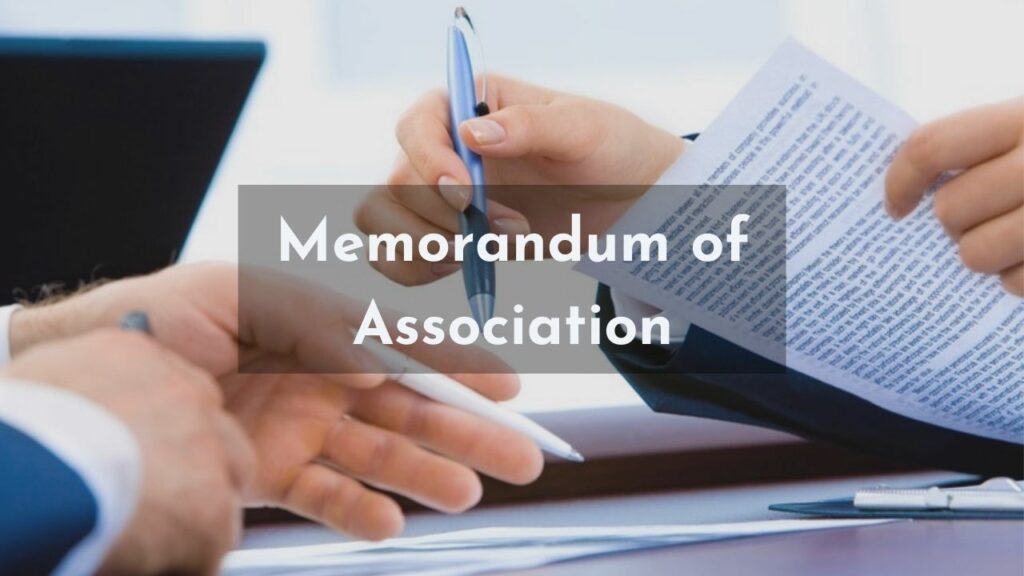A Memorandum of Association (MOA) is a legally binding agreement that contains the specifics of a business’s constitution and serves as the foundation for the business’s structure. It is referred to as a company’s charter. It establishes the scope of the business’s operations, the aims for which it was founded, the power granted to the organisation, and its interaction with the outside world.
The establishment of the memorandum of agreement is the first step toward business registration. The MOA must be subscribed to by the company members upon the business’s formation. Subscribing to an MOA entails affixing one’s mark or signature to the document in order to certify or approve its contents.

Format of Memorandum of Association
Every company’s MOA should contain the following five clauses:
- Name clause
- Registered office clause
- Object clause
- Liability clause
- Capital clause
Name Clause:
This clause defines the company’s name. The company’s name should not be similar to that of another current business. Additionally, if the firm is a private one, the name should include the phrase ‘Private Limited’ at the end. And, in the event of a public corporation, the word “Limited” should be added to the end of its name. For instance, ABC Private Limited in the case of a private firm and ABC Ltd in the event of a public corporation.
Registered Office Clause:
This clause defines the state in which the company’s registered office is located. This information assists in determining the Registrar of Companies’ jurisdiction. The firm is obliged to notify the Registrar of Companies of the location of the registered office within 30 days of the formation or beginning of the company.
Object clause
This clause states the objective with which the company is formed. The objectives can be further divided into the following 3 subcategories:
Main Objective: It states the main business of the company
Incidental Objective: These are the objects ancillary to the attainment of the main objects of the company.
Other objectives: Any other objects which the company may pursue and are not covered in above (a) and (b)
Liability clause.
It establishes the company’s members’ liability. In an unlimited corporation, the members’ responsibility is limitless, but in a company limited by shares, the members’ liability is limited to the amount due on their share. For a business limited by guarantee, the members’ liability is limited to the sum agreed upon by each member.
Capital clause
This provision specifies the maximum amount of capital that a business may raise, often known as the authorized/nominal capital of the business. This also explains why such capital is divided into a fixed number of shares with a fixed value per share.
Frequently Asked Questions
Is the MoA and Articles of Association (AoA) of a company the same?
No. The Memorandum of Association (MoA) is distinct from the Articles of Association (AoA). The MoA contains the fundamental data about the firm, whereas AoA contains the company’s internal rules and regulations. The AoA reports to the MoA.
Is MoA required for the registration of a company?
Yes. Before submitting an application for business registration, the owners must prepare the firm’s memorandum of association. It is a statutory document that must be provided to the Registrar of Companies when registering a business. The Memorandum of Agreement must be signed by all of the prospective company’s directors and members.
What is the purpose of MoA?
The primary objective of the Memorandum of Agreement is to limit the extent of the company’s operations and authority. A corporation is authorised to engage in just those activities that are within the scope of the MoA’s authority. Any action taken by the corporation that is not covered by the MOU is ultra virus. The term “ultra viral act” refers to an act committed by a business that exceeds its capabilities. Members and depositors of a business may petition the company tribunal to enjoin the firm from engaging in conduct that might be seen as a violation of the company’s Memorandum of Association.
Is the MoA required for a startup?
Yes. Every business, whether private, public or one-person, requires a Memorandum of Agreement. Thus, if a startup wishes to register as a company under the Companies Act, 2013, the business must draught a memorandum of understanding prior to submitting an application for registration.
No. The Limited Liability Partnership is registered under the 2008 Limited Liability Partnership Act. An LLP is needed to draught the LLP deed under the LLP Act, 2008. Thus, LLPs are exempt from the requirement to produce a memorandum of agreement.
Does an LLP (Limited Liability Partnership) need MoA?
No. The Limited Liability Partnership is registered under the 2008 Limited Liability Partnership Act. An LLP is needed to draught the LLP deed under the LLP Act, 2008. Thus, LLPs are exempt from the requirement to produce a memorandum of agreement.
Do all the companies require MoA?
Yes, Every business must have a memorandum of understanding since it specifies the scope of its activities. The Memorandum of Agreement details the company’s full structure. It is required to be filed with the Registrar of Companies. It is a public document, and anybody who pays the requisite fees to the Ministry of Corporate Affairs can examine the company’s memorandum of association (MCA).
What is the use of an MoA?
The Memorandum of Agreement establishes the scope and authority of a business, beyond which it cannot function. It governs how the business interacts with the outside world. A corporation cannot be registered without a memorandum of agreement. It assists anyone interested in entering into a contractual connection with the business in gaining knowledge about the business. It is sometimes referred to as the business’s charter since it provides information about the firm, its members, and their liabilities.

